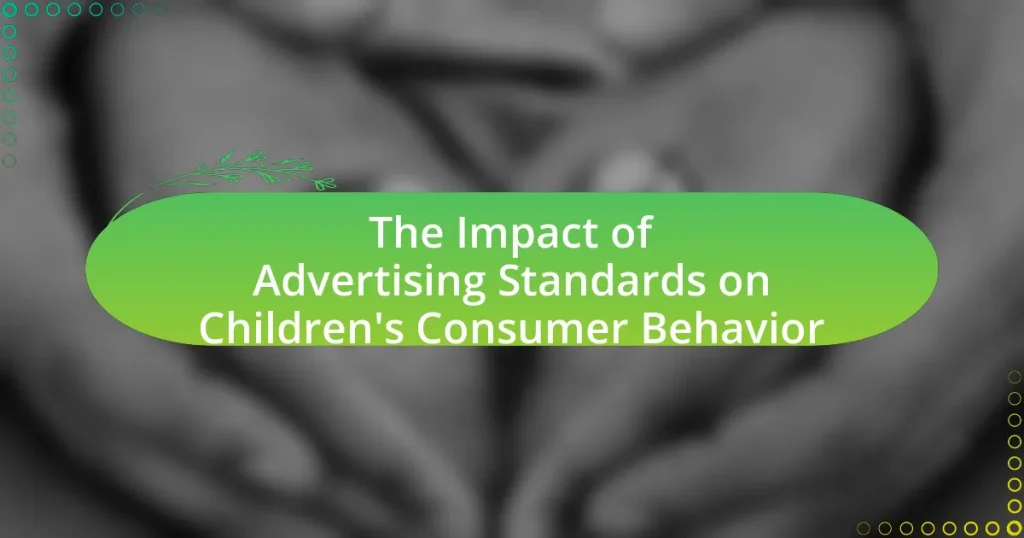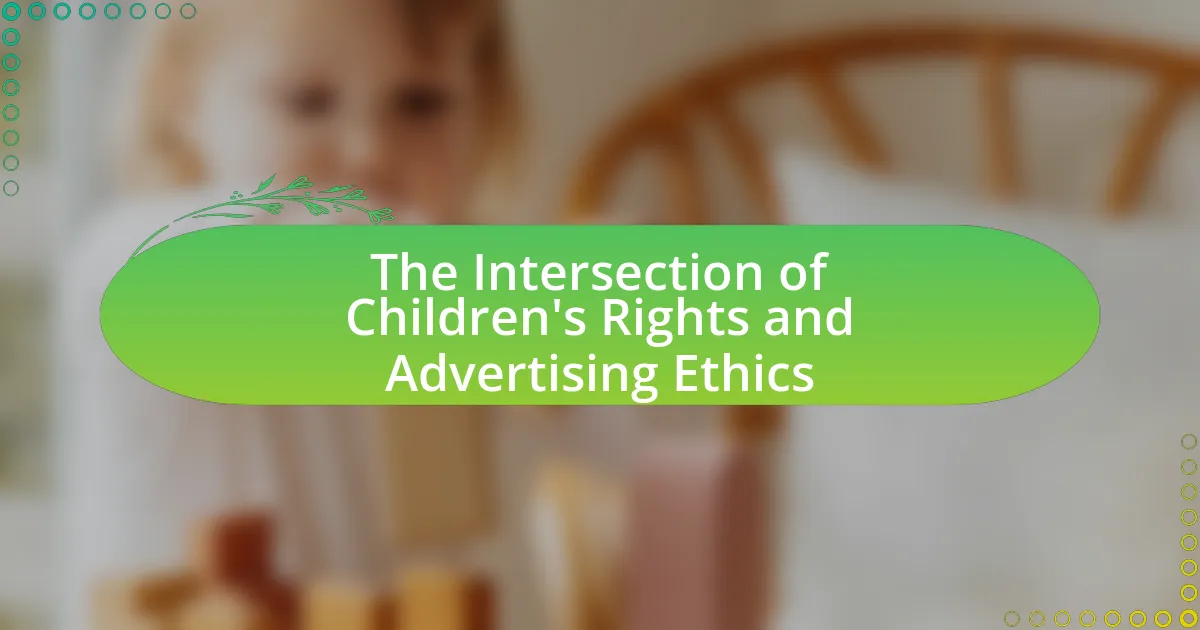The article examines the impact of advertising standards on children’s consumer behavior, highlighting the guidelines and regulations designed to ensure truthful and fair advertising. It discusses how these standards protect vulnerable groups, particularly children, from misleading marketing practices and promote ethical advertising. The article also explores the specific regulations governing marketing to children, the psychological effects of advertisements, and the variations in advertising standards across different countries. Additionally, it addresses the challenges and criticisms of current advertising standards, the role of parental influence, and the importance of education in helping children navigate advertising messages effectively.

What are Advertising Standards and Their Purpose?
Advertising standards are a set of guidelines and regulations that govern the content and presentation of advertisements to ensure they are truthful, fair, and not misleading. Their purpose is to protect consumers, particularly vulnerable groups like children, from deceptive marketing practices and to promote ethical advertising practices among businesses. For instance, the Federal Trade Commission (FTC) in the United States enforces advertising standards that require advertisements to be substantiated and not misleading, which helps maintain a fair marketplace and fosters consumer trust.
How do advertising standards regulate marketing to children?
Advertising standards regulate marketing to children by establishing guidelines that limit the types of messages and methods used in advertisements directed at young audiences. These regulations often prohibit misleading claims, require clear disclosures about the nature of products, and restrict the use of certain persuasive techniques that exploit children’s naivety. For example, the Children’s Advertising Review Unit (CARU) enforces guidelines that mandate advertisements to be age-appropriate and not to encourage unhealthy behaviors, such as excessive consumption of junk food. These standards aim to protect children from exploitation and ensure that marketing practices are ethical and responsible.
What specific guidelines are included in advertising standards for children?
Advertising standards for children include specific guidelines that prohibit misleading claims, require clear identification of advertising, and restrict the use of certain persuasive techniques. These guidelines aim to protect children from exploitation and ensure that advertisements are age-appropriate. For instance, the Children’s Advertising Review Unit (CARU) mandates that advertisements should not contain deceptive content and must be clearly distinguishable from programming. Additionally, the guidelines limit the use of emotional appeals and pressure tactics, such as urging children to persuade their parents to make purchases. These standards are supported by research indicating that children are particularly vulnerable to advertising messages, which can influence their consumer behavior significantly.
How do these guidelines vary across different countries?
Advertising guidelines for children vary significantly across countries due to differing cultural values, legal frameworks, and regulatory bodies. For instance, in Sweden and Norway, there are strict bans on advertising directed at children under 12, reflecting a strong emphasis on protecting children from commercial exploitation. In contrast, the United States has more lenient regulations, allowing advertising to children with certain disclosures, but still requiring adherence to the Children’s Online Privacy Protection Act (COPPA) to protect children’s data online. These variations illustrate how countries prioritize child welfare in advertising differently, influenced by societal norms and legislative environments.
Why are advertising standards important for children’s consumer behavior?
Advertising standards are crucial for children’s consumer behavior because they protect young audiences from misleading or harmful marketing practices. These standards ensure that advertisements are age-appropriate, truthful, and do not exploit children’s inexperience or vulnerability. Research indicates that children are particularly susceptible to persuasive advertising techniques, which can lead to unhealthy consumption patterns and materialistic attitudes. For instance, a study published in the Journal of Advertising Research found that children exposed to unregulated advertising were more likely to request unhealthy food products, highlighting the need for strict advertising guidelines to mitigate such influences.
What psychological effects do advertisements have on children?
Advertisements have significant psychological effects on children, influencing their perceptions, behaviors, and emotional responses. Children are particularly susceptible to advertising due to their developing cognitive abilities, which makes them more likely to accept messages without critical evaluation. Research indicates that exposure to advertisements can lead to increased materialism, as children often equate happiness with the acquisition of products. A study published in the Journal of Consumer Research by authors such as John A. Bargh and Tanya L. Chartrand found that children exposed to advertisements are more likely to develop preferences for branded products over non-branded ones, demonstrating the impact of marketing on their choices. Additionally, advertisements can shape children’s self-esteem and body image, as they often portray idealized lifestyles and appearances, leading to feelings of inadequacy or dissatisfaction.
How do advertising standards aim to protect children from harmful marketing practices?
Advertising standards aim to protect children from harmful marketing practices by implementing regulations that restrict misleading and exploitative advertising targeted at minors. These standards often prohibit advertisements that could manipulate children’s inexperience or credulity, ensuring that marketing messages are age-appropriate and do not promote unhealthy behaviors, such as excessive consumption of junk food or the use of harmful products. For example, the Children’s Online Privacy Protection Act (COPPA) in the United States establishes guidelines that limit the collection of personal information from children under 13, thereby reducing the risk of targeted advertising that could exploit their vulnerabilities. Additionally, organizations like the Advertising Standards Authority (ASA) in the UK enforce codes that specifically address the portrayal of children in advertisements, ensuring that content is not only truthful but also considerate of children’s developmental stages.
How do Advertising Standards Influence Children’s Consumer Behavior?
Advertising standards significantly influence children’s consumer behavior by regulating the content and presentation of advertisements targeted at young audiences. These standards aim to protect children from misleading or harmful marketing practices, ensuring that advertisements are age-appropriate and do not exploit their vulnerability. For instance, the Children’s Advertising Review Unit (CARU) guidelines stipulate that advertisements should not contain deceptive claims and must be clearly distinguishable from programming. Research indicates that adherence to these standards can lead to a decrease in the effectiveness of persuasive advertising techniques, thereby reducing the likelihood of children making impulsive purchasing decisions. A study published in the Journal of Advertising Research found that children exposed to compliant advertisements exhibited less desire for the advertised products compared to those exposed to non-compliant ads, highlighting the direct impact of advertising standards on shaping children’s consumer preferences and behaviors.
What changes in consumer behavior can be observed in children due to advertising standards?
Changes in consumer behavior observed in children due to advertising standards include reduced susceptibility to misleading advertisements and increased critical thinking regarding product claims. Advertising standards, such as those implemented by the Federal Trade Commission, aim to limit deceptive marketing practices targeted at children, leading to a more discerning audience. Research indicates that children exposed to stricter advertising regulations demonstrate a greater ability to question the validity of advertisements, as evidenced by a study published in the Journal of Consumer Research, which found that children aged 8 to 12 showed improved skepticism towards promotional messages when exposed to regulated advertising environments. This shift in behavior reflects a growing awareness of marketing tactics and encourages healthier consumption patterns among young audiences.
How do children respond to advertisements that comply with these standards?
Children generally respond positively to advertisements that comply with established advertising standards. Research indicates that when advertisements are transparent, truthful, and age-appropriate, children are more likely to engage with the content and develop favorable attitudes towards the advertised products. For instance, a study published in the Journal of Advertising Research found that children exposed to ethical advertising practices demonstrated increased brand recall and preference compared to those who viewed misleading advertisements. This suggests that adherence to advertising standards not only fosters trust but also enhances children’s overall consumer behavior.
What role do parental influences play in children’s responses to advertising?
Parental influences significantly shape children’s responses to advertising by guiding their understanding and interpretation of marketing messages. Research indicates that children often model their attitudes and behaviors based on parental feedback and discussions about advertisements. For instance, a study published in the Journal of Advertising Research found that children whose parents actively engage in conversations about advertising are more likely to develop critical thinking skills regarding marketing tactics. This engagement helps children discern persuasive intent and reduces susceptibility to misleading advertisements. Therefore, parental involvement plays a crucial role in mediating children’s reactions to advertising, fostering a more analytical approach to consumer messages.
How do advertising standards impact the types of products marketed to children?
Advertising standards significantly restrict the types of products marketed to children by enforcing guidelines that prioritize their health and well-being. These standards often limit the promotion of unhealthy food and beverages, toys that may pose safety risks, and products that exploit children’s naivety. For instance, the Children’s Food and Beverage Advertising Initiative (CFBAI) in the United States encourages companies to advertise only healthier dietary choices to children, resulting in a notable decrease in the marketing of high-calorie, low-nutrient foods. This regulatory framework aims to protect children from misleading advertisements and to promote healthier consumption patterns, thereby shaping the overall landscape of products available to young consumers.
What categories of products are most affected by advertising standards?
Categories of products most affected by advertising standards include food and beverages, toys, and personal care items. These categories are heavily regulated to protect children from misleading claims and harmful marketing practices. For instance, the Federal Trade Commission (FTC) in the United States has specific guidelines that restrict advertising of unhealthy food products to children, aiming to combat childhood obesity. Additionally, the Children’s Online Privacy Protection Act (COPPA) imposes strict rules on how personal care products can be marketed to minors, ensuring that advertisements do not exploit children’s naivety. These regulations demonstrate the significant impact advertising standards have on these product categories, shaping how they are presented to young consumers.
How do advertising standards shape the messaging used in children’s advertising?
Advertising standards significantly shape the messaging used in children’s advertising by imposing regulations that ensure content is appropriate and not misleading. These standards often restrict the use of certain persuasive techniques, such as exaggeration or fear tactics, which could exploit children’s vulnerability. For instance, the Children’s Advertising Review Unit (CARU) guidelines in the United States mandate that advertisements must not misrepresent the product or its benefits, ensuring that messages are clear and truthful. Additionally, these standards often require that advertisements promote healthy behaviors and lifestyles, thereby influencing the types of products marketed to children. Research indicates that adherence to these standards can lead to a reduction in the promotion of unhealthy food options, thereby impacting children’s dietary choices and overall consumer behavior.

What are the Challenges and Criticisms of Advertising Standards?
The challenges and criticisms of advertising standards primarily revolve around their effectiveness in protecting vulnerable populations, particularly children. Critics argue that existing standards often fail to adequately address the psychological impact of advertising on children, leading to increased materialism and unhealthy consumption patterns. For instance, a study published in the Journal of Advertising Research found that children exposed to high levels of advertising are more likely to develop a preference for unhealthy foods, highlighting the inadequacy of current regulations in safeguarding children’s health. Additionally, enforcement of advertising standards can be inconsistent, with varying interpretations across different jurisdictions, which undermines their overall effectiveness.
What are the main criticisms of current advertising standards for children?
The main criticisms of current advertising standards for children include their inadequacy in protecting young audiences from misleading content, the promotion of unhealthy food choices, and the lack of stringent regulations on digital advertising. Critics argue that existing guidelines often fail to address the persuasive techniques used in advertisements, which can manipulate children’s emotions and desires. For instance, a study by the American Psychological Association highlights that children are particularly vulnerable to advertising tactics that exploit their developmental stage, leading to increased materialism and unhealthy eating habits. Additionally, the rise of digital platforms has outpaced regulatory frameworks, allowing for targeted ads that can further exploit children’s inexperience with media literacy.
How effective are these standards in truly protecting children?
The effectiveness of advertising standards in protecting children is moderate, as they provide a framework for limiting harmful content but often lack enforcement and adaptability. Research indicates that while regulations can reduce exposure to misleading advertisements, children remain vulnerable to persuasive marketing techniques, particularly in digital environments. For instance, a study by the American Psychological Association found that children aged 8 to 12 are significantly influenced by advertisements, demonstrating that existing standards may not fully address the complexities of modern advertising strategies.
What loopholes exist in advertising standards that may be exploited?
Loopholes in advertising standards that may be exploited include vague definitions of what constitutes misleading advertising and the use of persuasive techniques that target children without clear disclosure. For instance, many advertising regulations do not explicitly define “misleading,” allowing advertisers to create ambiguous claims that can be interpreted in various ways. Additionally, techniques such as product placement in children’s programming can be used without proper labeling, leading to confusion about what is an advertisement versus regular content. Research by the American Psychological Association highlights that children are particularly susceptible to these tactics, as they often lack the cognitive ability to critically evaluate advertising messages.
How do stakeholders perceive the effectiveness of advertising standards?
Stakeholders perceive the effectiveness of advertising standards as crucial for protecting children from misleading marketing practices. Research indicates that parents and educators believe these standards help ensure that advertisements are age-appropriate and do not exploit children’s vulnerabilities. A study by the American Psychological Association found that 75% of parents support stricter regulations on advertising aimed at children, highlighting a consensus on the need for effective standards to mitigate negative impacts on children’s consumer behavior.
What are the views of parents and educators on advertising standards?
Parents and educators generally advocate for stricter advertising standards to protect children from misleading marketing practices. They express concerns that current advertising often exploits children’s naivety, leading to unhealthy consumer habits and unrealistic expectations. Research conducted by the American Psychological Association indicates that children are particularly vulnerable to persuasive advertising, which can influence their preferences and purchasing decisions. This vulnerability has prompted calls for regulations that limit the types of products marketed to children and ensure that advertisements are truthful and not deceptive.
How do advertisers and companies respond to these standards?
Advertisers and companies respond to advertising standards by adjusting their marketing strategies to comply with regulations aimed at protecting children. These adjustments often include creating content that is age-appropriate, ensuring transparency in advertising, and avoiding misleading claims. For instance, in response to the Children’s Online Privacy Protection Act (COPPA), companies have implemented stricter data collection practices and enhanced parental controls to safeguard children’s information. Additionally, research indicates that compliance with advertising standards can lead to increased consumer trust, as brands that adhere to ethical guidelines are perceived more favorably by parents and guardians.
What practical steps can be taken to improve advertising standards for children?
To improve advertising standards for children, regulatory bodies should implement stricter guidelines that limit the types of products advertised to children and the methods used in such advertising. For instance, regulations can prohibit advertisements for unhealthy food and beverages during children’s programming, as studies show that exposure to such ads increases the likelihood of poor dietary choices among children. Additionally, enforcing transparency in advertising by requiring clear labeling of promotional content can help children distinguish between entertainment and marketing, thereby reducing the potential for manipulation. Research from the American Psychological Association indicates that children are particularly vulnerable to persuasive advertising techniques, underscoring the need for these protective measures.
How can policymakers enhance the effectiveness of advertising regulations?
Policymakers can enhance the effectiveness of advertising regulations by implementing stricter guidelines that specifically target misleading advertisements aimed at children. Research indicates that children are particularly vulnerable to deceptive marketing practices, which can lead to unhealthy consumer behaviors. For instance, the American Psychological Association has highlighted that children under the age of eight cannot distinguish between commercials and regular programming, making them susceptible to manipulation. By establishing clear definitions of what constitutes misleading advertising and enforcing penalties for violations, policymakers can create a safer advertising environment for children. Additionally, incorporating educational programs that inform children about advertising tactics can empower them to critically evaluate advertisements, further reinforcing the effectiveness of these regulations.
What role can education play in helping children understand advertising?
Education plays a crucial role in helping children understand advertising by equipping them with critical thinking skills to analyze and evaluate marketing messages. Through structured curricula that include media literacy, children learn to identify persuasive techniques used in advertisements, such as emotional appeals and misleading claims. Research indicates that programs focusing on media literacy can significantly enhance children’s ability to discern the intent behind advertisements, leading to more informed consumer behavior. For instance, a study published in the Journal of Advertising Research found that children who participated in media literacy programs demonstrated a 30% increase in their ability to critically assess advertisements compared to those who did not receive such education. This evidence underscores the importance of education in fostering a generation of consumers who can navigate the complexities of advertising effectively.






